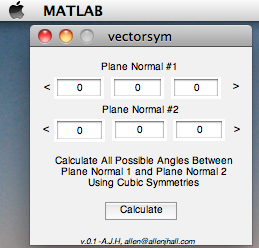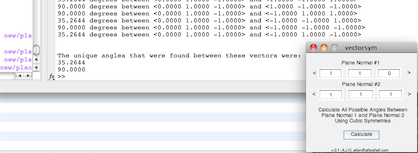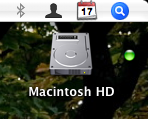 I’ve made a few small gui programs (MATLAB) for finding all unique angles for vectors (or plane normals) in both the cubic and tetragonal crystal spaces. I thought I’d share them here, as I finally worked out a few kinks. Be aware that the little gui’s use the command window to output their results. Some of my other programs would output latex code so that they could be pasted directly into a thesis for tables etc., but this one just uses the standard out (ala the command window in Matlab).
I’ve made a few small gui programs (MATLAB) for finding all unique angles for vectors (or plane normals) in both the cubic and tetragonal crystal spaces. I thought I’d share them here, as I finally worked out a few kinks. Be aware that the little gui’s use the command window to output their results. Some of my other programs would output latex code so that they could be pasted directly into a thesis for tables etc., but this one just uses the standard out (ala the command window in Matlab).
Essentially you enter the vectors for the two planes of interest, then hit calculate, and all the unique angle solutions for the crystal space you chose (one gui for each crystal space right now- no interest in complicating it by combining at this time) gets output in the command window.
I populate some orientation matrices based upon the vectors you give. Then, from matrix calculations, using tetragonal and crystal symmetry operations, we determine all the symmetric orientations. Then, a simple subspace() command gives us the angles of greatest rise (dihedral angle) between the symmetric orientations. The calculations for these operations can be found in my Thesis (if it ever gets published), but can also be found in: V. Randle and O. Engler. Texture Analysis: Macrotexture, Microtexture & Orientation Mapping. CRC Press, 2000.
Please note- it’s your job to check if these are correct, I make no warranties about this stuff. ![]() It should work, but feel free to go in and edit everything to your liking. If you use my code, don’t worry too much about citing me (if you do, I appreciate it, but I often leave out others who have contributed also).
It should work, but feel free to go in and edit everything to your liking. If you use my code, don’t worry too much about citing me (if you do, I appreciate it, but I often leave out others who have contributed also).
These are very simple, but hopefully they’ll help a bit for those working in cubic and tetragonal spaces.
Here’s the cubic symmetry angle calculator:
Vector Angle Calculator Cubic SymmetriesHere’s the tetragonal symmetry angle calculator:
Vector Angle Calculator Tetragonal Symmetries
I hope they work for you- please let me know if you have problems, if I have time I’ll try and help.





